
|
SkyingWednesday, 9th April 2003, West Yorkshire |
![]()
![]()
![]()
![]() Rocks | History |
Workshop |
Links | Home
Page
Rocks | History |
Workshop |
Links | Home
Page
![]()
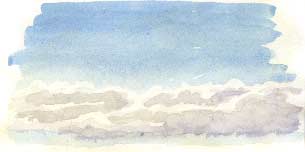 Constable
was fascinated by clouds; he bought the latest books on meteorology and
he went out 'skying': making studies of clouds. The art historian Conal
Shields, who should know, once told me that none of Constable's
cloud studies was ever used in any of his finished paintings.
Constable
was fascinated by clouds; he bought the latest books on meteorology and
he went out 'skying': making studies of clouds. The art historian Conal
Shields, who should know, once told me that none of Constable's
cloud studies was ever used in any of his finished paintings.
There's a wonderful bank of cumulus going past beyond the wood this afternoon. By the time I've got hold of my sketchbook and paints it has drifted away to the south: there's a cold wind from the north, or north-east.
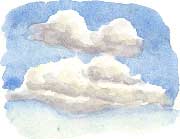 'Another
question. How is it that clouds are so complete, so sharp in outline?'
asks John Stuart Collis in his essay The Mystery
of Clouds, written in 1943 and published in his book Down to
Earth, 'We look up into the sky and see these chiselled leviathans
swimming through the ocean of the air at the bottom of which we walk,
these drastic shapes each margined against the blue with a termination
as clean as the Cliffs of Moher; but they are not solids, and the last
thing we should expect is this firm binding of the unboundaried moisture
in the airy wastes.'
'Another
question. How is it that clouds are so complete, so sharp in outline?'
asks John Stuart Collis in his essay The Mystery
of Clouds, written in 1943 and published in his book Down to
Earth, 'We look up into the sky and see these chiselled leviathans
swimming through the ocean of the air at the bottom of which we walk,
these drastic shapes each margined against the blue with a termination
as clean as the Cliffs of Moher; but they are not solids, and the last
thing we should expect is this firm binding of the unboundaried moisture
in the airy wastes.'
Kafka under a Cloud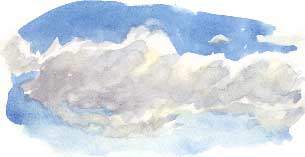
He quotes Franz Kafka who, when feeling miserable on
a Sunday afternoon, wrote that he was 'astonished sometimes by the almost
unending senseless passing of the dull clouds'. I'm quite worried about
that Kafka.
Watercolour Clouds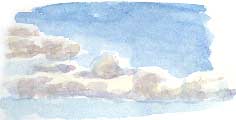
I don't bother sketching a pencil outline but work quickly, drawing with the brush before the cloud changes its shape beyond recognition. I use cerulean blue for the sky background, leaving the clouds as white paper showing through. I should be able to get the same colour using French ultramarine with a spot of yellow mixed in but when I've got my larger paintbox with a pan of cerulean blue I might as well use that. Cerulean means 'the colour of the cloudless sky; deep blue, azure' so it is a useful, but not essential, colour to include in a watercolour box.
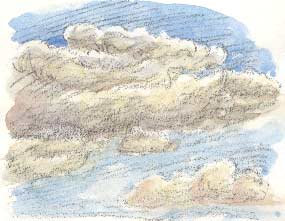 I
use raw sienna, as a change from yellow ochre, as a background wash for
the clouds. In the first sketch of the bank of clouds you can see that
I've put a thin raw sienna across the whole area, even behind the blue.
I wanted this wash to be no more than a hint so I blotted off the surplus
with a tissue. Clouds are rarely snow white so a thin wash of raw sienna
helps give that creamy colour. It's more transparent than yellow ochre
so it is more suitable for producing an even, transparent wash.
I
use raw sienna, as a change from yellow ochre, as a background wash for
the clouds. In the first sketch of the bank of clouds you can see that
I've put a thin raw sienna across the whole area, even behind the blue.
I wanted this wash to be no more than a hint so I blotted off the surplus
with a tissue. Clouds are rarely snow white so a thin wash of raw sienna
helps give that creamy colour. It's more transparent than yellow ochre
so it is more suitable for producing an even, transparent wash.
I may be catching the cloudiness of clouds but I'm not getting that 'chiselled' form that Collis comments on. For my last sketch I try 4B pencil. I wouldn't normally use 4B, I go for HB or 2B, and I've always considered 4B too soft but it's ideal for quickly sketching in the cloud, encouraging me to sketch in as much in tone as in line. It picks up the texture of the fairly smooth cartridge paper I'm using, creating a stippled areas in the shadows.
I was going to leave this pencil sketch as a tonal study but I can't
resist seeing what a watercolour wash will look like over it. It seems
to work well and it's a quicker way of establishing the light and shade
on the cloud than working with watercolour alone.
![]()
![]() Next page | Previous
page | This day in 2000
| This month | Nature
Diary | Home
Page
Next page | Previous
page | This day in 2000
| This month | Nature
Diary | Home
Page
![]()